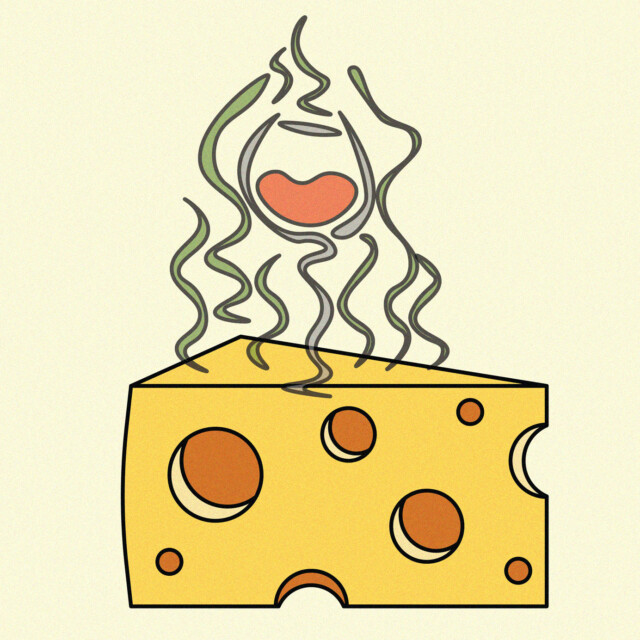I was the weirdo kid who liked blue cheese and Brie. As an adult, my love for cheese blossomed so extravagantly that it became my career.
There are many categories of cheese to fall for, from soft-ripened cheeses like Camembert to Cheddars so sharp they’ll cut your tongue (in a good way). But I’ve always had an extra soft spot for washed rind cheeses, which I think of broadly as “stinky.” There’s nothing like gooey, pungent cheeses that can be scooped up with a crusty piece of baguette or a spoon. It’s my personal quest to convert as many people as possible to the delicious stinky side.
The bold complexity of these cheeses can make them tricky to pair with wine. But don’t let that deter you from trying — the right match can elevate the whole experience and make these sometimes intimidating bites more approachable.
What Does Stinky Cheese Mean, Exactly?
Washed rind cheeses get their name from their production process, during which they’re literally washed with brine, wine, beer, or spirits as they mature. The moisture helps to cultivate specific edible bacteria (most often, Brevibacterium linens) on the rind, giving the cheeses pretty orange hues; meaty, rich flavor; and a generous depth like nothing else. Cheeses like Epoisses, Reblochon, Stinking Bishop, and Taleggio are great examples. Sometimes, a stinky cheese’s bark is bigger than its bite — its pungent aroma might make way to a surprisingly mild flavor.
Stinky cheeses and washed rind cheeses aren’t perfect synonyms, more like overlapping circles on a Venn diagram. “I find that most people think about blue cheese first when they hear the term ‘stinky cheese,’” says John Montez, who coordinates events and education at New York’s Murray’s Cheese. “A surprising amount of people are not familiar with the washed rind family, so I like the term because it is a convenient way of talking about both washed rinds and blue cheeses.”
For the purposes of this piece, we’ll use that definition. Blue cheeses are stinky in their own way — earthy and salty, with varying degrees of intensity.
What To Consider When Pairing Stinky Goodness
Stinky cheese demands a strong beverage to stand up to its oomph. Wine, like all pairings, should complement rather than compete. “One of the most important aspects of pairing is matching the intensities,” Montez explains. Balance is integral to any successful food and drink pairing. You might break this down into the five components of taste: salty, sweet, bitter, sour, and umami. But at the end of the day, “the palate knows immediately when something is off balance,” says Montez — and likewise, when the drink and the cheese really sing together.
Even for professionals, pairing washed rinds and wines can pose a challenge. “These cheeses often have a lot of umami, which tends to bring out the harder characteristics of wine,” Montez says. “It can make the wine taste more bitter and be more drying on the palate.”
Bitter aperitifs, sweet wines, and sour ciders are solidly on the intense end of the taste spectrum, but they can be extremely useful in a pairing context. Two brawny flavors can tame one another; an excellent rule of stinky cheese pairing is to embrace big flavors.
Wine Pairings to Explore
Sweet wine and blue cheese are a wonderful couple and a no-brainer pairing. “Port and Stilton is a classic for a reason,” Montez says. Dessert wine’s sweetness acts as an excellent foil for the salty bite of blue. Spanish fortified wine sherry is also a great accompaniment. Try nearly syrupy Pedro Ximenez with the barnyardy blue Cabrales from Asturias, or the luscious sheep’s milk Serra de Estrella.
Another wine to enjoy with the funkier finds is Riesling. Its high acidity and subtle sweetness balance the richness of cheeses like sweet-salty Gorgonzola Dolce, or pudgy Munster d’Alsace.
If your heart is set on red wine, seek a bottle with plenty of body and juicy fruit, but subtle tannins. (Too many tannins will leave an unpleasant bitterness.) Australian Shiraz, jammy zinfandel, and sprightly Grenache are good bets. Natural wines are fun to play with, too. A wine with an effervescent fizz will break up the richness of a soft, punchy fromage.
Beer, Seltzer, and Pairings Beyond Wine
If you’re looking to enjoy a stinky cheese with a non-wine beverage, there are many superb options. Montez swears by a funky Basque-style cider, which plays nicely with the umami of intense washed rinds like Epoisses. “There is a real meatiness to a pairing like that that brings to mind a cheeseburger complete with pickles and mustard,” he says.
I love digging into heady porters and stouts with pudding-like, woodsy Harbison or the super-seasonal, silky Vacherin Mont d’Or. The rich, almost dessert-like beers stand up to their complex flavor and lush texture.
Coffee with blue cheese is a surprisingly wonderful dessert. “I usually drink my coffee black, but with blue cheese, I want lots of cream and sugar,” Montez says. After dinner, a macchiato and a slice of Rogue River blue is an elegant, satisfying treat.
Seltzer water and lemon works great with cheese, too. The acid in the lemon helps disperse the richness of creamy cheeses, and the bubbles spread the cheese across the palate so that you can appreciate it even more. For a heavenly afternoon snack, break out a citrus-y seltzer and some von Trapp Family Farmstead Oma with notes of brown butter and bacon, or raw milk Meadow Creek Dairy Grayson, which tastes of just-cut grass and caramelizing onions.
Stink has never been so delicious.
